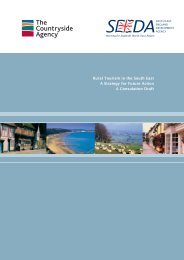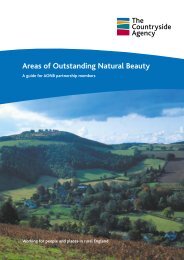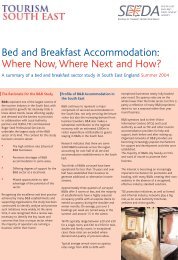The Historic Environment: A Force for Our Future - TourismInsights
The Historic Environment: A Force for Our Future - TourismInsights
The Historic Environment: A Force for Our Future - TourismInsights
You also want an ePaper? Increase the reach of your titles
YUMPU automatically turns print PDFs into web optimized ePapers that Google loves.
Department <strong>for</strong> Culture, Media and Sport<br />
Architecture and <strong>Historic</strong> <strong>Environment</strong> Division<br />
<strong>The</strong> <strong>Historic</strong> <strong>Environment</strong>:<br />
A <strong>Force</strong> <strong>for</strong> <strong>Our</strong> <strong>Future</strong>
Cover picture:<br />
Restoration work on stone statues,<br />
Kedleston Hall, Derbyshire,<br />
(courtesy <strong>The</strong> National Trust)
<strong>The</strong> <strong>Historic</strong> <strong>Environment</strong>: A <strong>Force</strong> <strong>for</strong> <strong>Our</strong> <strong>Future</strong> 3<br />
<strong>The</strong> <strong>Historic</strong> <strong>Environment</strong>: A <strong>Force</strong> <strong>for</strong> <strong>Our</strong> <strong>Future</strong><br />
Contents<br />
Foreword 4<br />
<strong>The</strong> <strong>Historic</strong> <strong>Environment</strong> – A New Vision 7<br />
Providing Leadership 11<br />
Realising Educational Potential 17<br />
Including and Involving People 25<br />
Protecting and Sustaining 33<br />
Optimising Economic Potential 45<br />
Summary of Action Points 53
4<strong>The</strong> <strong>Historic</strong> <strong>Environment</strong>: A <strong>Force</strong> <strong>for</strong> <strong>Our</strong> <strong>Future</strong><br />
Foreword<br />
By the Rt Hon. Tessa Jowell MP, Secretary of State <strong>for</strong> Culture, Media and Sport<br />
and the Rt Hon. Stephen Byers MP, Secretary of State <strong>for</strong> Transport,<br />
Local Government and the Regions.<br />
England’s historic environment is one of our<br />
greatest national resources. From prehistoric<br />
monuments to great country houses, from medieval<br />
churches to the towns of the Industrial Revolution,<br />
it is a uniquely rich and precious inheritance.<br />
But it is about more than bricks and mortar. It<br />
embraces the landscape as a whole, both urban and<br />
rural, and the marine archaeology sites around our<br />
shores. It shows us how our own <strong>for</strong>ebears lived. It<br />
embodies the history of all the communities who<br />
have made their home in this country. It is part of<br />
the wider public realm in which we can all<br />
participate.<br />
This historic environment is something from which<br />
we can learn, something from which our economy<br />
benefits and something which can bring<br />
communities together in a shared sense of<br />
belonging. With sensitivity and imagination, it can<br />
be a stimulus to creative new architecture and<br />
design, a <strong>for</strong>ce <strong>for</strong> regeneration and a powerful<br />
contributor to people’s quality of life.<br />
But this environment is fragile. Successive<br />
governments have developed policies to protect it.<br />
Buildings are listed and archaeological sites<br />
scheduled. Substantial public funding is available <strong>for</strong><br />
repair and refurbishment. A complex web of<br />
relationships has been established between the<br />
many national and local bodies which care <strong>for</strong> the<br />
treasures of the past and make them accessible to<br />
millions of people from home and abroad.<br />
At the start of a new century it seems timely to<br />
look at existing policies and structures and to assess<br />
how well they are working and how they can be<br />
improved. <strong>The</strong> publication of this Statement<br />
concludes the most wide-ranging review of policy<br />
in this area <strong>for</strong> several decades. <strong>The</strong> first stage was<br />
led by English Heritage, working with an<br />
unprecedented range of partner organisations from<br />
within the sector and more widely, and culminated<br />
in the Power of Place report in December 2000.<br />
That report has been of immense value, both in<br />
setting an agenda <strong>for</strong> action across the whole sector<br />
and in shaping the Government’s own vision, and<br />
we pay tribute to all who were involved in its<br />
preparation. We welcome too the action that is<br />
already in hand within the sector to take <strong>for</strong>ward its<br />
recommendations.<br />
We are publishing this Statement at a time when<br />
the public’s enthusiasm <strong>for</strong> the past is increasingly<br />
evident, not least in the strong media focus on<br />
archaeology and history. New, more creative<br />
approaches are being used to present historic sites<br />
and buildings to visitors and to engage a wider<br />
audience. <strong>Our</strong> heritage continues to be a massive<br />
draw <strong>for</strong> tourists. As such it makes a major<br />
contribution to the economy and underpins huge<br />
numbers of jobs, importantly in rural and deprived<br />
communities as well as in traditional economic<br />
centres. <strong>The</strong>re is, however, much more to be done.<br />
Indeed this sector can be regarded as something of<br />
a sleeping giant both in cultural and economic<br />
terms. We need to find new ways of reaching and<br />
empowering excluded individuals and communities.<br />
We need to develop new policies to realise economic<br />
and educational potential through modernised<br />
structures and improved service delivery.<br />
Achieving these objectives involves the use of many<br />
different policy instruments and the Statement
<strong>The</strong> <strong>Historic</strong> <strong>Environment</strong>: A <strong>Force</strong> <strong>for</strong> <strong>Our</strong> <strong>Future</strong> 5<br />
looks in detail at all of them: funding; legislation;<br />
policy guidance; delivery mechanisms;<br />
reprioritisation; and partnership working. It makes<br />
proposals to enable organisations to work better<br />
together and statutory regimes to operate more<br />
effectively. It looks at ways of enhancing the historic<br />
environment’s contribution to education, both<br />
within the school curriculum and through lifelong<br />
learning, and of replenishing essential conservation<br />
skills. It responds to people’s desire to broaden the<br />
definition of what should be valued and champions<br />
the role of historic assets in the development and<br />
regeneration processes and as a focus <strong>for</strong><br />
community cohesion.<br />
This document is far from being the end of the<br />
story. On the contrary, it is only the beginning of a<br />
major drive to unlock the full potential of our<br />
historic assets. <strong>The</strong> Government is currently<br />
carrying out fundamental reviews of both the<br />
Heritage Lottery Fund and English Heritage,<br />
which, once concluded, will shape the development<br />
of these two critically important bodies, putting<br />
them in strong positions to deliver this challenging<br />
agenda. We are publishing a Green Paper on the<br />
planning system, proposing measures to make the<br />
system more efficient, effective, customer-orientated<br />
and transparent. That will make local government<br />
better placed to deliver proactive help in<br />
developments affecting the historic environment.<br />
major interest in the subject and have taken part in<br />
the preparation of this document. Not least among<br />
these is the Department <strong>for</strong> <strong>Environment</strong>, Food and<br />
Rural Affairs, whose involvement reflects the<br />
importance of the historic environment <strong>for</strong> rural<br />
areas and vice versa. Indeed, the White Paper <strong>Our</strong><br />
Countryside: <strong>The</strong> <strong>Future</strong>. A Fair Deal <strong>for</strong> Rural<br />
England, published in November 2000, included a<br />
number of measures and initiatives of direct benefit<br />
to the historic environment. And while the<br />
Statement applies only to England, we are very<br />
much aware that many of the issues it addresses<br />
affect the whole of the United Kingdom and we are<br />
there<strong>for</strong>e keeping in touch with colleagues in<br />
Northern Ireland, Scotland and Wales.<br />
<strong>Our</strong> vision is ambitious. We have set out an agenda<br />
which can over time deliver more attractive towns<br />
and cities; a prosperous and sustainable countryside;<br />
world-class tourist attractions; new jobs; and<br />
learning, vibrant and self-confident communities.<br />
This is what we believe the historic environment<br />
can contribute to contemporary life. This is why we<br />
must continue to protect and sustain it, both <strong>for</strong> our<br />
own benefit and that of future generations.<br />
This statement encompasses the full range of the<br />
Government’s interest in the historic environment.<br />
Although the lead responsibility rests with the<br />
Department <strong>for</strong> Culture, Media and Sport and the<br />
Department <strong>for</strong> Transport, Local Government and<br />
the Regions, other parts of Government have a<br />
Tessa Jowell<br />
Stephen Byers
A NEW VISION
<strong>The</strong> <strong>Historic</strong> <strong>Environment</strong>: A <strong>Force</strong> <strong>for</strong> <strong>Our</strong> <strong>Future</strong> 7<br />
<strong>The</strong> <strong>Historic</strong> <strong>Environment</strong> – A New Vision<br />
1 <strong>The</strong> past is all around us. We live our lives,<br />
whether consciously or not, against a rich<br />
backdrop <strong>for</strong>med by historic buildings, landscapes<br />
and other physical survivals of our past. But the<br />
historic environment is more than just a matter of<br />
material remains. It is central to how we see<br />
ourselves and to our identity as individuals,<br />
communities and as a nation. It is a physical<br />
record of what our country is, how it came to be,<br />
its successes and failures. It is a collective<br />
memory, containing an infinity of stories, some<br />
ancient, some recent: stories written in stone,<br />
brick, wood, glass, steel; stories inscribed in the<br />
field patterns, hedgerows, designed landscapes<br />
and other features of the countryside. England’s<br />
history is a gradual accumulation of movement<br />
and arrivals, new stories attaching themselves to<br />
old. Urban and rural landscapes reflect this<br />
layering of experience and develop their own<br />
distinct characteristics.<br />
2 Building materials and styles can define and<br />
bind regions, localities and communities just as<br />
potently as ethnic background, dialect or sporting<br />
loyalties. <strong>Historic</strong> landscapes or iconic buildings<br />
can become a focus of community identity and<br />
pride and proclaim that identity and pride to the<br />
wider world. <strong>The</strong> Royal Liver Building in<br />
Liverpool, Leeds Town Hall, Lincoln Cathedral,<br />
Clifton Suspension Bridge, the Backs at<br />
Cambridge, the dry-stone walls of the Dales, to<br />
name but a few, are all seen by residents and<br />
visitors alike as encapsulating the very essence of<br />
place. At a more local level a historic church or<br />
park can help define a neighbourhood and create a<br />
sense of local cohesion. Once lost, these defining<br />
features cannot be replaced.<br />
3 Internationally, the imprint of history on our<br />
environment is a powerful aspect of our image as a<br />
nation. And the value of this rich legacy as a<br />
magnet <strong>for</strong> tourists is massive in economic terms.<br />
Main picture:<br />
Clevedon Pier, North Somerset.<br />
Newcastle Quayside regeneration.
8 <strong>The</strong> <strong>Historic</strong> <strong>Environment</strong>: A <strong>Force</strong> <strong>for</strong> <strong>Our</strong> <strong>Future</strong><br />
<strong>The</strong> <strong>Historic</strong> <strong>Environment</strong> – A New Vision<br />
4 <strong>The</strong> importance we attach to our past shows<br />
itself in many different ways. <strong>The</strong> popularity of<br />
television programmes such as Channel 4’s Time<br />
Team and the BBC’s History 2000 season is one<br />
indicator. <strong>The</strong> number of visits made to historic<br />
properties is another. In 1999-2000 English<br />
Heritage welcomed nearly 12 million visitors to<br />
its sites. No other heritage organisation in<br />
England can match the National Trust’s<br />
membership of 2.7 million. Each year more and<br />
more people take advantage of Heritage Open<br />
Days to see <strong>for</strong> themselves, free of charge, a vast<br />
range of buildings around the country that are<br />
normally closed to the public or charge an<br />
admission fee. In 1999 more than a million visits<br />
were made to the 2,400 participating properties.<br />
5 <strong>The</strong> diversity of ways in which people<br />
experience or relate to our historic environment is<br />
one of its strengths. For some it is a medium <strong>for</strong><br />
learning about the past; <strong>for</strong> others a visitor<br />
experience; <strong>for</strong> many it provides employment; <strong>for</strong><br />
still more it provides a home or place of work; <strong>for</strong><br />
everyone it is a contributor to overall quality of<br />
life. This diversity is reflected in the complexity<br />
of interests involved: individuals; communities;<br />
visitors; owners; the voluntary sector; business;<br />
central and local government.<br />
6 <strong>The</strong> interplay between these different interests<br />
creates a dynamism which has produced some<br />
exciting developments in recent years. Consider,<br />
<strong>for</strong> example, the massive strides taken to increase<br />
people’s access to the historic environment, both<br />
physically and by way of electronic media. Ten<br />
years ago the concept of using a website, such as<br />
English Heritage’s, to help with a school project<br />
on Hadrian’s Wall would have been unimaginable.<br />
And the needs of people with disabilities are<br />
increasingly catered <strong>for</strong> at many sites across the<br />
country. Linked with this increased emphasis on<br />
accessibility, great strides have been made in<br />
realising the educational potential of historic sites,<br />
particularly <strong>for</strong> school-age children, and in<br />
developing a more inclusive approach to their<br />
presentation and interpretation. Substantial<br />
progress has also been made in recognising and<br />
harnessing the contribution that historic<br />
buildings can make to economic and community<br />
regeneration. English Heritage’s Heritage<br />
Economic Regeneration Scheme and the Heritage<br />
Lottery Fund’s Townscape Heritage Initiative<br />
have both acted as important catalysts <strong>for</strong><br />
community-led renewal and as a spur to wider<br />
investment, both public and private.<br />
7 Another important development has been the<br />
gradual widening of the definition of what people<br />
regard as their heritage and the way in which the<br />
national organisations have responded to this. <strong>The</strong><br />
National Trust’s purchase of Paul McCartney‘s<br />
childhood home in Liverpool was perhaps the<br />
most high-profile signal of this responsiveness,<br />
but the investment in urban parks and gardens<br />
and the preservation of back-to-back housing in<br />
Birmingham and Manchester are also significant.
<strong>The</strong> <strong>Historic</strong> <strong>Environment</strong>: A <strong>Force</strong> <strong>for</strong> <strong>Our</strong> <strong>Future</strong> 9<br />
8 Up until now, Government policy towards the<br />
historic environment has been expressed mainly<br />
through <strong>for</strong>mal planning guidance and the<br />
provision of funds to bodies such as English<br />
Heritage and the Heritage Lottery Fund.<br />
Initiatives relating to the countryside have also<br />
played a significant role. Such functions are<br />
crucially important and will continue to occupy a<br />
central place in the delivery of policy. But there is<br />
a need now <strong>for</strong> Government both to articulate a<br />
more complete vision <strong>for</strong> the sector and to look<br />
systematically at the means of translating the<br />
vision into reality. That is what this Statement<br />
is about.<br />
9 <strong>The</strong> Government looks to a future in which:<br />
■ public interest in the historic environment is<br />
matched by firm leadership, effective<br />
partnerships, and the development of a sound<br />
knowledge base from which to develop<br />
policies;<br />
■ the full potential of the historic environment<br />
as a learning resource is realised;<br />
■ the historic environment is accessible to<br />
everybody and is seen as something with<br />
which the whole of society can identify and<br />
engage;<br />
■ the historic environment is protected and<br />
sustained <strong>for</strong> the benefit of our own and future<br />
generations;<br />
■ the historic environment’s importance as an<br />
economic asset is skilfully harnessed.<br />
10 This is a bold vision but an achievable one.<br />
<strong>The</strong> historic environment has much to contribute<br />
to the Government’s wider agenda of creating and<br />
maintaining a sustainable environment alongside<br />
economic stability. Improving the quality of life in<br />
both urban and rural areas, by allowing people to<br />
feel a greater sense of ownership of and<br />
engagement with the places in which they live,<br />
work and play, is an important theme of the<br />
Government’s 2002 Spending Review. <strong>The</strong><br />
historic environment <strong>for</strong>ms part of the wider local<br />
environment of streets and public spaces which<br />
the Government is committed to improving.<br />
11 <strong>The</strong> following chapters set out a detailed<br />
programme of action in support of the<br />
Government’s vision. It is a programme which<br />
the Government itself will lead, but its<br />
implementation will depend on the partnership<br />
and support of a great many others, both<br />
individuals and organisations. It will require<br />
commitment, unity of purpose and receptiveness<br />
to new ideas and ways of working. It will involve<br />
making good use of all the available tools:<br />
legislation; funding; policy guidance;<br />
restructuring; and partnership working.<br />
12 Power of Place demonstrated that the sector<br />
could work together to excellent effect. We need<br />
now to build on that momentum and harness the<br />
commitment and expertise which have already<br />
been displayed. In this way we can quickly set<br />
about delivering the programme <strong>for</strong> change set<br />
out in this Statement and fulfil the vision of a<br />
historic environment standing at the very heart of<br />
our national life.
PROVIDING LEADERSHIP
<strong>The</strong> <strong>Historic</strong> <strong>Environment</strong>: A <strong>Force</strong> <strong>for</strong> <strong>Our</strong> <strong>Future</strong> 11<br />
Providing Leadership<br />
<strong>The</strong> task: to respond to public interest in the historic environment with firm<br />
leadership, effective partnerships and a sound knowledge base from which to<br />
develop policies.<br />
1.1 <strong>The</strong> review of historic environment policies led<br />
by English Heritage and culminating in the Power<br />
of Place report was overseen by a steering group<br />
comprising more than twenty organisations. <strong>The</strong>se<br />
organisations reflected the breadth and diversity of<br />
interest in historic environment policy and ranged<br />
from the National Trust to the Black <strong>Environment</strong><br />
Network, from the British Property Federation to<br />
Groundwork UK. One of the key issues raised in<br />
Power of Place was the need <strong>for</strong> firm leadership.<br />
Just as the range of interests involved with the<br />
historic environment is diverse, so is the need <strong>for</strong><br />
leadership. This chapter explores the role of<br />
leadership and the importance of partnership.<br />
Power of Place also emphasised that effective<br />
policy-making must always be underpinned by<br />
good quality evidence and this chapter there<strong>for</strong>e<br />
looks at ways in which the evidence base can be<br />
expanded and refined.<br />
Government leadership<br />
1.2 <strong>The</strong> issue of leadership begins with central<br />
Government itself. <strong>The</strong> historic environment is of<br />
significance across the whole field of Government<br />
policy, spanning economic development, education<br />
and training and rural affairs. <strong>The</strong> Department <strong>for</strong><br />
Culture, Media and Sport (DCMS) has the role of<br />
overall champion <strong>for</strong> the historic environment,<br />
while sharing with the Department <strong>for</strong> Transport,<br />
Local Government and the Regions (DTLR)<br />
responsibility <strong>for</strong> a number of key areas of policy,<br />
in particular the regulatory framework. <strong>The</strong><br />
Department <strong>for</strong> <strong>Environment</strong>, Food and Rural<br />
Affairs (DEFRA) has a key policy role in respect<br />
of rural areas and in providing financial incentives<br />
and advice. None the less this is a Statement <strong>for</strong> the<br />
whole of Government. Given the span of issues and<br />
Departments which have an impact on the historic<br />
environment or vice versa, the Government<br />
acknowledges the need to develop a cross-<br />
Whitehall approach to promote awareness of the<br />
historic environment through all relevant<br />
Departments and maximise its contribution to the<br />
Government’s programme as a whole.<br />
Main picture:<br />
Hadrian’s Wall, Cawfields.<br />
(courtesy Hadrian’s Wall<br />
Tourism Partnership)<br />
Divers from the Hampshire<br />
and Wight Trust <strong>for</strong> Maritime<br />
Archaeology excavating the<br />
Alum Bay Wreck off the Isle of Wight<br />
(courtesy Jonathan Adams)
12 <strong>The</strong> <strong>Historic</strong> <strong>Environment</strong>: A <strong>Force</strong> <strong>for</strong> <strong>Our</strong> <strong>Future</strong><br />
Providing Leadership<br />
To this end:<br />
■ <strong>The</strong> historic environment will be included<br />
as part of the remit of Green Ministers.<br />
<strong>The</strong> role of Green Ministers is to consider the<br />
impact of Government policies on sustainable<br />
development and to improve the per<strong>for</strong>mance<br />
of Government Departments in contributing<br />
to sustainable development. Drawing specific<br />
attention to the relevance of the historic<br />
environment will help ensure that it is taken<br />
into account in wider decision-making and<br />
thereby constitute an element of the<br />
Government’s support <strong>for</strong> sustainable<br />
development. Green Ministers will also be<br />
responsible <strong>for</strong> ensuring that historic<br />
environment policies are taken into account in<br />
decisions concerning the use and development<br />
of the Government’s own properties;<br />
■ DCMS, as lead sponsor Department, will<br />
involve DTLR and DEFRA in discussions<br />
about the strategic direction of English<br />
Heritage and the Heritage Lottery Fund.<br />
This will include, where appropriate, agreeing<br />
funding priorities;<br />
■ DCMS will work with the devolved<br />
administrations to ensure that, where<br />
appropriate, the United Kingdom’s<br />
interests in international <strong>for</strong>a are properly<br />
represented.<br />
Local government leadership<br />
1.3 <strong>The</strong> part played by local authorities in the<br />
stewardship of the historic environment is of<br />
fundamental importance. Like Government, their<br />
role can be complex, and covers many different<br />
functions: custodian, regulator, grant-giver,<br />
rescuer of last resort. <strong>The</strong> Government looks to<br />
local authorities to adopt a positive approach<br />
to the management of the historic<br />
environment within their area and the<br />
monitoring of its condition. It urges<br />
authorities to appoint champions <strong>for</strong> the<br />
historic environment within their management<br />
structures.<br />
1.4 All local authorities stand to benefit from the<br />
skills of properly qualified conservation staff. <strong>The</strong><br />
Government there<strong>for</strong>e supports the work<br />
currently being done by English Heritage and the<br />
Institute of <strong>Historic</strong> Building Conservation to<br />
assess current levels of conservation staff within<br />
local authorities. Elected members should also<br />
have the best possible training to enable them to<br />
make high-quality decisions on local historic<br />
environment issues. <strong>The</strong> issue of training is<br />
included within the guidance <strong>for</strong> councillors<br />
published as part of the Modernising Planning<br />
initiative and will be further considered in the<br />
Planning Green Paper. <strong>The</strong> Government urges<br />
all local authorities to ensure that elected<br />
members have access to training in respect of<br />
the historic environment wherever it is needed.
<strong>The</strong> <strong>Historic</strong> <strong>Environment</strong>: A <strong>Force</strong> <strong>for</strong> <strong>Our</strong> <strong>Future</strong> 13<br />
English Heritage<br />
1.5 In 1998 the Government merged English<br />
Heritage with the Royal Commission on the<br />
<strong>Historic</strong>al Monuments of England and gave<br />
English Heritage the status of lead body <strong>for</strong> the<br />
sector. <strong>The</strong> intention was to create an organisation<br />
which would assume a leadership role as advocate<br />
<strong>for</strong> the sector, in implementing and interpreting<br />
Government policy and in developing strategic<br />
initiatives to benefit the whole sector. It was in this<br />
capacity that English Heritage was commissioned<br />
by the Government to lead the process which<br />
resulted in Power of Place.<br />
1.6 As part of its regular series of quinquennial<br />
reviews, the Government is once again<br />
examining the role and functions of English<br />
Heritage to assess its fitness <strong>for</strong> purpose.<br />
This presents an excellent opportunity to consider<br />
the extent to which English Heritage has<br />
developed its leadership role and how it might<br />
further develop its capacity in this respect. It also<br />
offers an opportunity to consider afresh how<br />
service delivery (to local authorities, owners and<br />
developers and other interests) might be<br />
improved. <strong>The</strong> Government and English Heritage<br />
regard the quinquennial review as the occasion to<br />
refocus the organisation in a way which will<br />
enable it to deliver the vision set out by the<br />
Government in this Statement, besides taking<br />
<strong>for</strong>ward the agenda <strong>for</strong> the sector already<br />
<strong>for</strong>mulated by Power of Place. <strong>The</strong> first stage of<br />
the review will be completed by the spring of<br />
2002 and will in<strong>for</strong>m the Government’s 2002<br />
Spending Review.<br />
Working in partnership<br />
1.7 <strong>The</strong> process which produced Power of Place<br />
demonstrated, if demonstration was necessary, that<br />
the historic environment sector has immense<br />
reserves of energy and commitment. It also<br />
confirmed that the sector is diverse and spans a<br />
huge range of interest groups, not all of whom<br />
would regard themselves as being primarily in the<br />
heritage business. It brought home more than ever<br />
the importance of the historic environment sector<br />
developing close partnerships with other interests:<br />
<strong>for</strong> example, the natural environment sector, the<br />
tourism industry and those involved in<br />
contemporary architecture. Just as the Government<br />
needs to bring together the various Departmental<br />
interests in the historic environment, so the sector<br />
needs both to strengthen its internal relationships<br />
and be prepared to work outside its traditional<br />
boundaries.<br />
1.8 English Heritage and its partners on the<br />
cross-sectoral Power of Place Steering Group are<br />
considering how best to build on the partnership<br />
working established during that process and<br />
harness the energies of the sector as a whole.<br />
<strong>The</strong> Government has commissioned English<br />
Heritage, in consultation with partner<br />
organisations, to <strong>for</strong>mulate a five-year<br />
strategy <strong>for</strong> the development of effective<br />
working relationships both within the<br />
historic environment sector and with other<br />
relevant interests.
14<strong>The</strong> <strong>Historic</strong> <strong>Environment</strong>: A <strong>Force</strong> <strong>for</strong> <strong>Our</strong> <strong>Future</strong><br />
Providing Leadership<br />
Stonehenge World Heritage Site<br />
<strong>The</strong> Department <strong>for</strong> Culture, Media and Sport, the<br />
Department <strong>for</strong> Transport, Local Government and<br />
the Regions, English Heritage, the National Trust,<br />
English Nature, the Highways Agency, Wiltshire<br />
County Council and Salisbury District Council are<br />
all partners in an ambitious project to restore the<br />
dignity and isolation of Stonehenge, our greatest<br />
prehistoric monument, and enable people to enjoy<br />
and appreciate it fully.<br />
When completed, the scheme will reunite<br />
Stonehenge and its surrounding monuments in their<br />
natural chalk downland landscape setting and<br />
provide radically improved visitor access to the<br />
World Heritage Site. To help visitors appreciate and<br />
interpret the monument and its setting, a new<br />
world-class visitor centre will be established outside<br />
the boundaries of the Site. This strongly led and<br />
coordinated approach will help ensure that<br />
Stonehenge is preserved and managed in a way<br />
befitting its international importance.<br />
1.9 This strategy will need to cover partnership<br />
working at both national and regional level. At<br />
regional level the Government will want to see<br />
English Heritage building on the work of the<br />
Regional Cultural Consortia and reflecting the<br />
move to greater regionalisation more generally.<br />
Expanding the knowledge base<br />
1.10 For all organisations concerned with the<br />
historic environment, a solid evidence base <strong>for</strong><br />
policy-making is an essential. For grant-givers such<br />
as English Heritage and the Heritage Lottery Fund,<br />
good quality research is vital to in<strong>for</strong>m the direction<br />
of resources. For the Government and local<br />
authorities as legislators and regulators, evidence is<br />
crucial to the process both of framing policy and of<br />
evaluating its impact.<br />
Mapping the seabed<br />
<strong>The</strong> Hampshire and Wight Trust <strong>for</strong> Maritime<br />
Archaeology is involved in a number of projects which<br />
involve the mapping of underwater historical and<br />
archaeological material dating from different periods.<br />
One scheme is a survey of the rich archaeology that<br />
has accumulated in Langstone Harbour over the<br />
centuries, including worked flints from the<br />
Mesolithic Age, flints and pottery from the Bronze<br />
Age, and a fully submerged circle of timbers from<br />
AD 740-780. <strong>The</strong> aim is to collect together a wide<br />
range of data covering as many aspects of the<br />
Harbour’s history as possible. Central to this<br />
recording process is the development of a<br />
Geographic In<strong>for</strong>mation System as a means of<br />
holding, manipulating and displaying this diverse<br />
data in a way that will be accessible through a set of<br />
maps. This will enable records of the nature of the<br />
artefacts and their location to be combined with<br />
historical and environmental context in<strong>for</strong>mation,<br />
thereby creating a rich multi-media research and<br />
interpretation tool. It will also allow the data to be<br />
easily accessible on the Internet.
<strong>The</strong> <strong>Historic</strong> <strong>Environment</strong>: A <strong>Force</strong> <strong>for</strong> <strong>Our</strong> <strong>Future</strong> 15<br />
1.11 One of recommendations in Power of Place<br />
was that the Government should<br />
commission regular state of the historic<br />
environment reports to monitor the condition of<br />
our historic assets (whether or not <strong>for</strong>mally<br />
designated), to assess the pressures facing them<br />
and to analyse their contribution to contemporary<br />
life in cultural, economic and social terms. Such<br />
reports would provide yardsticks with which to<br />
measure the achievements, not only of the sector<br />
itself but also of local government, business and<br />
local communities, in looking after the historic<br />
environment and enhancing its contribution to<br />
contemporary life. Achievements of local<br />
government might also contribute to the<br />
development of a Best Value indicator and also<br />
the scope <strong>for</strong> the historic environment featuring<br />
in the Beacon Councils scheme. <strong>The</strong> Government<br />
supports the recommendation and has asked<br />
English Heritage to produce a pilot <strong>Historic</strong><br />
<strong>Environment</strong> Report during 2002.<br />
1.12 Research relating to the historic environment<br />
is undertaken by a wide range of organisations,<br />
both within the sector itself and elsewhere (<strong>for</strong><br />
instance, in academic institutions). While<br />
acknowledging that a great deal of high-quality<br />
work has already been done or is currently in<br />
progress, the Government believes that a<br />
coordinated approach to research is essential if its<br />
full benefit is to be realised. <strong>The</strong> Government has<br />
commissioned English Heritage, working with<br />
partner organisations, to frame a coordinated<br />
approach to research across the sector, with<br />
the aim of ensuring that needs are clearly<br />
identified, priorities established and<br />
duplication avoided.<br />
1.13 <strong>The</strong> Sites and Monuments Records<br />
maintained by local authorities are acknowledged<br />
as an extremely valuable resource, with many<br />
potential uses. On one level they are essential to<br />
the effective operation of the planning system, but<br />
they also have the potential to be a powerful<br />
educational tool, both <strong>for</strong> the professional and<br />
academic users and <strong>for</strong> the wider public. <strong>The</strong><br />
Government welcomes the recommendation in<br />
Power of Place that the service offered by these<br />
Records should be enhanced, that their scope<br />
should be more comprehensive, and that access to<br />
the in<strong>for</strong>mation held should be facilitated through<br />
use of the electronic media.<br />
1.14 Sites and Monuments Records expanded and<br />
improved in this way could embrace historic<br />
buildings (both those statutorily listed and those<br />
of local interest), conservation areas, historic<br />
battlefields, and historic parks and gardens. In this<br />
way they would become comprehensive <strong>Historic</strong><br />
<strong>Environment</strong> Record Centres. <strong>The</strong>se would be<br />
significant developments and careful thought<br />
must be given to the technology involved in<br />
making electronic access to the expanded data<br />
widely available, given variations in the way the<br />
Records are currently operated. <strong>The</strong>re are a<br />
number of models that might be adopted to<br />
provide a new system. <strong>The</strong> Government will<br />
produce a consultation paper covering a range<br />
of options in the summer of 2002.
REALISING EDUCATIONAL POTENTIAL
<strong>The</strong> <strong>Historic</strong> <strong>Environment</strong>: A <strong>Force</strong> <strong>for</strong> <strong>Our</strong> <strong>Future</strong> 17<br />
Realising Educational Potential<br />
<strong>The</strong> task: to realise the full potential of the historic environment as a learning<br />
resource.<br />
2.1 <strong>The</strong> historic environment has immense value<br />
as an educational resource, both as a learning<br />
experience in its own right and as a tool <strong>for</strong> other<br />
disciplines. Whether at school, in further and<br />
higher education or in later life, the fabric of the<br />
past constitutes a vast reservoir of knowledge and<br />
learning opportunities. This is as true of the<br />
oldest archaeological remains as it is of buildings<br />
of the last fifty years. <strong>The</strong> history of buildings and<br />
places is also the history of the age in which they<br />
originated and of the eras in which they<br />
flourished. <strong>The</strong>y can tell us about the individuals<br />
and the institutions that created them and<br />
occupied them and about the societies and the<br />
local communities they served. Nor is the<br />
educational significance of the historic<br />
environment confined to the teaching of history.<br />
It is also relevant to subject areas as diverse as<br />
economics, geography, aesthetics, science,<br />
technology and design. Buildings and places can<br />
also play a role in developing a sense of active<br />
citizenship; by learning about their own<br />
environment and how they can participate in its<br />
evolution, people feel a greater sense of belonging<br />
and engagement.<br />
2.2 On another level, preserving the fabric of the<br />
past requires knowledge and expertise. Half the<br />
annual turnover of the construction industry<br />
relates to repairs and maintenance. Training in<br />
traditional craft skills is essential to ensure that<br />
existing buildings are satisfactorily maintained.<br />
This is a mainstream economic activity and we<br />
need to address the current severe lack of skills<br />
by developing an integrated approach to<br />
conservation training to ensure that the necessary<br />
skills are fostered and passed on from generation<br />
to generation.<br />
Main picture:<br />
Children examining an historic<br />
artefact during school trip.<br />
Excavations at Rivenhall Church,<br />
Essex<br />
(courtesy Essex County Council)<br />
Cathedral Camp restoration,<br />
Coventry Cathedral.<br />
(courtesy Cathedral Camp)
18 <strong>The</strong> <strong>Historic</strong> <strong>Environment</strong>: A <strong>Force</strong> <strong>for</strong> <strong>Our</strong> <strong>Future</strong><br />
Realising Educational Potential<br />
Lifelong learning<br />
2.3 <strong>The</strong> increasing public interest in local<br />
heritage, archaeology and genealogy<br />
demonstrates a keen appetite among all agegroups<br />
to learn about the past. <strong>The</strong> BBC’s<br />
History 2000 project made innovative links<br />
between television programmes and other<br />
resources, such as those available through<br />
libraries, museums and historic properties. <strong>The</strong><br />
project encouraged many people to follow up their<br />
interests with site visits and further reading, and<br />
vividly demonstrated the role of the historic<br />
environment in promoting knowledge of and<br />
enthusiasm <strong>for</strong> the past. <strong>The</strong> Government will<br />
work with English Heritage and the Learning<br />
and Skills Council to frame an action plan to<br />
increase opportunities <strong>for</strong> those who wish to<br />
develop their interests further, <strong>for</strong> example<br />
through further and higher education or<br />
vocational courses.<br />
Heritage Open Days<br />
Heritage Open Days are an immensely popular<br />
annual event. England’s contribution to the Council<br />
of Europe’s European Heritage Days initiative,<br />
Heritage Open Days, began in 1993 with 10,000<br />
people taking advantage of free access to <strong>for</strong>ty<br />
participating properties.<br />
<strong>The</strong> event has now grown beyond all recognition. In<br />
2000 nearly one million people took part, visiting<br />
3,035 properties in England, more than ever be<strong>for</strong>e.<br />
Popular locations include Westenhanger Castle,<br />
Hythe, a partly ruinous <strong>for</strong>tified house, dating from<br />
the fourteenth century; North Lees Hall, Hathersage,<br />
believed to be the inspiration <strong>for</strong> Thornfield Hall in<br />
Jane Eyre; Queen Street Mill in Burnley, a steampowered<br />
weaving shed with a coal-fired Lancashire<br />
boiler; Redbournbury Watermill, St Albans, a fully<br />
restored eighteenth century working watermill,<br />
producing stone ground organic flour; and the Sun Inn,<br />
Ipswich, a fifteenth century merchant’s house.<br />
2.4 <strong>The</strong> highly successful annual Heritage Open<br />
Days give the public an opportunity to experience<br />
some of England’s hidden architectural treasures.<br />
Other events such National Archaeology Days,<br />
Architecture Week and Museums and Galleries<br />
Month have helped promote wider public<br />
awareness of these different aspects of our<br />
cultural life. <strong>The</strong> Government will explore with<br />
English Heritage how best to develop the<br />
existing initiatives and whether this approach<br />
might now be extended to the historic<br />
environment as a whole in the <strong>for</strong>m of an<br />
annual <strong>Historic</strong> <strong>Environment</strong> Week.
<strong>The</strong> <strong>Historic</strong> <strong>Environment</strong>: A <strong>Force</strong> <strong>for</strong> <strong>Our</strong> <strong>Future</strong> 19<br />
School-age children<br />
2.5 English Heritage has a leading role in<br />
promoting the historic environment as<br />
a resource <strong>for</strong> use within the school curriculum.<br />
It has produced a wealth of educational material<br />
relating not only to its own properties but also to<br />
the historic environment more generally. It runs<br />
courses particularly directed at trainee and newly<br />
qualified teachers. And, as a member of the<br />
Qualifications and Curriculum Authority, English<br />
Heritage advises on material <strong>for</strong> the history<br />
curriculum, as well as on the citizenship<br />
component of the National Curriculum.<br />
2.6 Every child should have the opportunity to<br />
visit the widest possible range of historic sites.<br />
Over half a million children, students and teachers<br />
enjoy free admission annually to English Heritage<br />
sites on curriculum-based school trips. <strong>The</strong><br />
National Trust works closely with schools and<br />
welcomes over 600,000 children to its properties<br />
every year. Valuable educational schemes are also<br />
operated by the Royal Parks Agency, <strong>Historic</strong><br />
Royal Palaces and the <strong>Historic</strong> Houses Association.<br />
Whitehaven Citizenship Project<br />
Whitehaven was a prosperous Georgian town but its<br />
economy declined during the later part of the<br />
twentieth century. <strong>The</strong> restoration and regeneration<br />
of the town centre, harbour and castle during the<br />
1990s was led by the Whitehaven Development<br />
Company. Using the regeneration project, English<br />
Heritage has devised a study-programme <strong>for</strong> the<br />
citizenship curriculum, aimed at Key Stages 3 and 4.<br />
<strong>The</strong> study programme takes a number of significant<br />
features in the town and suggests fieldwork, the use<br />
of museums, historic buildings and archives. A<br />
template has been laid down which could be<br />
transferred easily to other towns or cities. <strong>The</strong><br />
programme provides many opportunities to develop<br />
skills and requires pupils to be engaged in the<br />
historical process: working independently, posing<br />
questions, devising theories and explanations (and<br />
testing them), analysing and evaluating sources,<br />
organising their material, and communicating it in a<br />
variety of <strong>for</strong>ms. <strong>The</strong> local authority was the key<br />
partner in the study and has been highly supportive.<br />
<strong>The</strong> programme demonstrates that understanding<br />
the history of a place and its regeneration can be<br />
central to the teaching of citizenship.
20 <strong>The</strong> <strong>Historic</strong> <strong>Environment</strong>: A <strong>Force</strong> <strong>for</strong> <strong>Our</strong> <strong>Future</strong><br />
Realising Educational Potential<br />
2.7 <strong>The</strong> Government is committed to providing<br />
universal free access to our national museums and<br />
galleries and, following the measures announced in<br />
the 2001 Budget, free entry became a reality <strong>for</strong><br />
everyone from 1 December 2001. Having delivered<br />
on free access <strong>for</strong> children at the main national<br />
galleries and museums, the Government will at an<br />
early opportunity consider, in consultation with<br />
relevant outside interests, how this principle<br />
might be extended to the historic environment<br />
sector. Possible options include free entry <strong>for</strong> all<br />
children to properties in the care of English<br />
Heritage and other bodies funded by central<br />
Government; or, alternatively, a voucher scheme <strong>for</strong><br />
schools to allow free access to any historic property,<br />
whether in public, charitable or private ownership.<br />
2.8 Visits to historic sites and buildings can really<br />
help history and other subjects come alive <strong>for</strong><br />
young people, sparking their creativity and<br />
imagination. However, research into similar<br />
activities in the arts has shown that a poorly<br />
organised day trip can be counterproductive and<br />
put children off <strong>for</strong> life. A more effective approach<br />
is to build sustained relationships between schools<br />
and local historic sites, so that young people get<br />
the chance to work with conservationists,<br />
archaeologists and other heritage professionals on<br />
longer term projects. Innovative programmes such<br />
as the Heritage Lottery Fund’s Young Roots<br />
scheme engage young people in heritage activities<br />
appropriate to their interests and age group.<br />
2.9 <strong>The</strong> Government’s new Creative Partnerships<br />
programme, due to be launched in April 2002,<br />
will help broker and support schools projects<br />
right across the cultural, creative and heritage<br />
fields. <strong>The</strong> £40 million scheme will initially<br />
target schools in sixteen of the most<br />
disadvantaged areas in England. <strong>The</strong> historic<br />
environment sector and its many professionals<br />
have a huge amount to offer young people and<br />
to the Creative Partnerships programme, and<br />
the Government would very much encourage<br />
historic environment organisations to<br />
get involved.<br />
Gawthorpe Hall<br />
<strong>The</strong> previous owner of Gawthorpe Hall in Lancashire,<br />
now owned by the National Trust, brought together<br />
a vast collection of Indian silks, which was used as<br />
inspiration <strong>for</strong> local mill workers making their own<br />
silk pieces. Building on this past, the National Trust is<br />
looking to broaden the appeal of Gawthorpe Hall by<br />
bringing the silk collection out of the basement and<br />
featuring it in an exhibition. Asian children from a<br />
nearby school have visited the property and are<br />
developing new interpretation of the labels in Urdu.
<strong>The</strong> <strong>Historic</strong> <strong>Environment</strong>: A <strong>Force</strong> <strong>for</strong> <strong>Our</strong> <strong>Future</strong> 21<br />
2.10 <strong>The</strong>re is a wide choice of published material<br />
which can assist both teachers and parents in<br />
developing children’s interest in the historic<br />
environment. <strong>The</strong> Department <strong>for</strong> Education and<br />
Skills and the Qualifications and Curriculum<br />
Authority have produced a range of leaflets to<br />
assist parents in supporting their children on<br />
specific history topics. <strong>The</strong> Department’s Learning<br />
Journey parents’ guides to the National<br />
Curriculum emphasise how parents can support<br />
their children’s history education through study<br />
of the local heritage. <strong>The</strong> Commission <strong>for</strong><br />
Architecture & the Built <strong>Environment</strong> (CABE)<br />
has published <strong>Our</strong> Street: Learning to See, which<br />
encourages primary school pupils to appreciate<br />
their local surroundings. It has also produced<br />
From One Street to Another <strong>for</strong> the Council of<br />
Europe, showing the direct relevance of buildings<br />
to people’s lives. <strong>The</strong> Government will work<br />
with CABE to ensure the widest possible<br />
circulation <strong>for</strong> these publications.<br />
2.11 Other cultural bodies have produced material<br />
<strong>for</strong> the National Curriculum which could be<br />
adapted <strong>for</strong> the historic environment. In<br />
particular, the British Film Institute’s Moving<br />
Images in the Classroom shows how secondary<br />
school teachers can use the moving image as a<br />
resource in studying a wide range of curriculum<br />
subjects. <strong>The</strong> Government has asked English<br />
Heritage to consider producing a comparable<br />
document <strong>for</strong> the historic environment.<br />
E-learning and Culture Online<br />
2.12 Learning through the use of electronic<br />
media can help bring history to life. Though<br />
never a substitute <strong>for</strong> the experience of seeing a<br />
historic site at first hand, this approach can<br />
involve the provision of e-learning or self-managed<br />
learning opportunities <strong>for</strong> a wide range of people,<br />
including socially excluded or disadvantaged<br />
groups. <strong>The</strong> National Grid <strong>for</strong> Learning brings<br />
together websites which support education and<br />
lifelong learning. Virtual access to many<br />
individual historic properties is available through<br />
their websites and the 24 Hour Museum portal.<br />
2.13 <strong>The</strong> Government is establishing a new body,<br />
with the working title Culture Online, to widen<br />
access to all cultural sectors through the use of<br />
digital technology. It will complement the<br />
National Grid <strong>for</strong> Learning with in<strong>for</strong>mation on,<br />
among other things, using the historic<br />
environment to enhance the National Curriculum.<br />
English Heritage will work closely with<br />
Culture Online in unlocking the potential<br />
of e-learning.<br />
Widening the perspective<br />
2.14 In recognition of the impact of David<br />
Anderson’s report, A Common Wealth, which<br />
placed education firmly at the heart of the<br />
museum sector, a similar report has been<br />
commissioned to assess the provision of learning<br />
opportunities within the historic environment<br />
sector, including the role of in<strong>for</strong>mation<br />
technology. <strong>The</strong> work is funded by the Attingham<br />
Trust and the results are expected in the autumn<br />
of 2002. <strong>The</strong> Government fully supports this<br />
project as a potential catalyst <strong>for</strong> the further<br />
development of historic environment education.
22 <strong>The</strong> <strong>Historic</strong> <strong>Environment</strong>: A <strong>Force</strong> <strong>for</strong> <strong>Our</strong> <strong>Future</strong><br />
Realising Educational Potential<br />
2.15 In the meantime, to build on the initiatives<br />
and activities described in this document, English<br />
Heritage will work closely with its partners to<br />
develop further the place of education within<br />
the historic environment sector. <strong>The</strong><br />
Government will propose targets <strong>for</strong> increased<br />
activity in this area <strong>for</strong> inclusion in English<br />
Heritage’s Funding Agreement <strong>for</strong> 2002-03.<br />
For example, the Government will ask English<br />
Heritage to build on its current work to increase<br />
awareness among teachers of the relevance of the<br />
historic environment as a resource <strong>for</strong> the widest<br />
possible range of subjects. It will also look to<br />
English Heritage to develop a strategy towards<br />
lifelong learning (including the targeting of<br />
groups such as older learners, families and<br />
disadvantaged young people) and to promote the<br />
historic environment in vocational training <strong>for</strong> the<br />
leisure and tourism sector. English Heritage is a<br />
key member of the Sponsored Bodies Education<br />
Network, which has been established by the<br />
Department <strong>for</strong> Culture, Media and Sport to<br />
develop a strategic approach by its sponsored<br />
bodies towards educational issues.<br />
Training in Craft Skills<br />
2.16 <strong>The</strong> Craft Skills Forum, led by UK SKILLS,<br />
comprises organisations with an interest in craft<br />
skills relating to the historic environment, such as<br />
stained glass conservation, stone-carving,<br />
thatching and dry-stone-walling. It seeks wider<br />
recognition of the importance of specialist<br />
traditional craft skills in sustaining the historic<br />
environment and in securing those skills <strong>for</strong> the<br />
future. One of its main priorities is to promote<br />
awareness of career development opportunities in<br />
schools, colleges and universities.<br />
2.17 <strong>The</strong> Building Skills Action Group, in<br />
partnership with English Heritage, the<br />
Construction Industry Training Board and other<br />
interests, aims to promote practical training in<br />
traditional construction skills, such as bricklaying,<br />
plastering and carpentry. Business and<br />
management skills are also important in making<br />
technical skills marketable. As the sectoral lead<br />
body English Heritage will coordinate the<br />
work of these two groups and others working<br />
in the area to ensure a coherent approach to<br />
meeting skills requirements.<br />
2.18 Several new education initiatives that offer<br />
good opportunities <strong>for</strong> developing training in<br />
craft skills. For example, new vocational GCSEs<br />
to be launched in 2002 will be supported by a<br />
programme of college and work placements,<br />
heralding a shift towards vocational courses and<br />
expanded opportunities <strong>for</strong> work-related learning.<br />
<strong>The</strong>se, along with the Government’s Modern<br />
Apprenticeships scheme <strong>for</strong> those aged 16 and<br />
over, will help young people learn craft skills. <strong>The</strong><br />
Learning and Skills Council is responsible <strong>for</strong><br />
addressing the education and training needs of<br />
those over 16. <strong>The</strong> Government is exploring<br />
with the Learning and Skills Council how<br />
some planned Centres of Vocational<br />
Excellence could specialise in skills relevant to<br />
the historic environment.
<strong>The</strong> <strong>Historic</strong> <strong>Environment</strong>: A <strong>Force</strong> <strong>for</strong> <strong>Our</strong> <strong>Future</strong> 23<br />
2.19 To help address the skills gap in a wide<br />
range of areas, including conservation craft skills,<br />
the Heritage Lottery Fund actively encourages<br />
applicants <strong>for</strong> grants to include training elements<br />
within their applications, especially <strong>for</strong> specialist<br />
craft skills, and to provide apprenticeships and<br />
work placements which may not readily be<br />
covered by the Learning and Skills Council.<br />
Within the framework of the England Rural<br />
Development Programme, operated by the<br />
Department <strong>for</strong> <strong>Environment</strong>, Food and Rural<br />
Affairs, support is available under the Rural<br />
Enterprise Scheme and Vocational Training<br />
Scheme <strong>for</strong> projects which develop rural<br />
conservation and craft skills such as thatching,<br />
dry-stone-walling, hedge-laying and traditional<br />
building restoration. <strong>The</strong> Government will<br />
encourage other grant-givers to give training<br />
a similar priority.<br />
Site management and interpretation skills<br />
2.20 In order to survive, visitor attractions must<br />
satisfy the needs and expectations of their<br />
customers. Customer care and interpretation skills<br />
are very important, and staff with a role to play in<br />
ensuring customer satisfaction must be supported<br />
in their development. Close attention must be<br />
given to the continued professional development<br />
of those running and managing historic<br />
attractions and this must include the fostering of<br />
skills in management, business management,<br />
marketing and fundraising.<br />
2.21 Many universities now provide courses on<br />
aspects of heritage or leisure management. <strong>The</strong><br />
Government has asked English Heritage to<br />
work with one or two major providers to<br />
develop courses which will match the skills<br />
required within the sector.<br />
Windsor Castle restoration<br />
In 1992 a large fire broke out in Windsor Castle,<br />
destroying nine of the principal state apartments<br />
and 100 other rooms. A major restoration project<br />
lasting five years was completed in November<br />
1997.<strong>The</strong> project was the largest rebuilding project<br />
undertaken in the past century. Teams of skilled<br />
carpenters, plasters, upholsterers, stonemasons and<br />
seamstresses were employed, using skills some of<br />
which had been thought lost. Wood carvers<br />
recreated giltwood carvings in the drawing rooms.<br />
Plasterers used fragments of plaster salvaged from<br />
the fire to recreate the traditional ceiling and wall<br />
designs. Rather then replicating the state rooms as<br />
they were be<strong>for</strong>e the fire, the opportunity was taken<br />
to return the rooms to their original appearance. In<br />
St George’s Hall the panelled roof was rebuilt with a<br />
brand new oak ceiling using traditional methods.
















